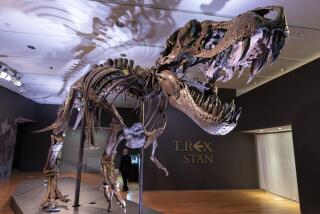Ancient T. rex tissue, or just old slime?
- Share via
Soft, organic material discovered inside a Tyrannosaurus rex fossil that scientists believed was 70-million-year-old dinosaur tissue may have been nothing more than ordinary slime, scientists said in a study published Wednesday.
Researchers reported in the online journal PLoS ONE that bacterial colonies infiltrating tiny cavities in the bones long after the dinosaurs died may have naturally molded into shapes resembling the tissues they replaced.
Carbon dating performed on one sample showed that the tissue-like material was modern, circa 1960.
After further examination with light and electron microscopy, researchers concluded that the substances were most likely remnants of biofilms, or layers of bacterial cells and the sticky molecules they secrete.
The finding sparked a strong response from the researchers who originally said they had found ancient dinosaur tissue.
Mary H. Schweitzer, the biologist from North Carolina State University who found the original material, said in a statement that errors in the current study “seem to underlie a fundamental misunderstanding of our work, our data and our interpretations.”
The dinosaur tissue was reported in 2005 after Schweitzer’s team, working at a remote dig site in Montana, was forced to break a T. rex femur into chunks small enough to be transported by helicopter. Inside were pieces of rubbery material that looked like blood vessels and bone marrow.
Subsequent analysis showed that proteins in the material resembled those found in birds, long thought to be close relatives of dinosaurs.
The find was received as one of the year’s most stunning scientific discoveries, although many scientists were skeptical that dinosaur tissue could survive tens of millions of years.
Hoping to find more samples of dinosaur tissues, a team of scientists at the Burke Museum of Natural History and Culture at the University of Washington decided to examine a fossilized turtle toe.
They cracked open the bone, put it under an electron microscope, and within minutes saw spheres reminiscent of blood cells, like those reported by Schweitzer’s group.
“We did the happy dance,” said Thomas Kaye, an associate researcher at the museum and the leader of the group.
The researchers then dissolved the bone in mild acid, exposing hidden tissue that resembled vessels and bone-forming cells. The findings were similar to those of Schweitzer’s group.
But as Kaye examined more fossils, he was puzzled that he found similar materials in nearly every bone. It didn’t make sense to him that so much tissue could have survived for millions of years.
The solution came from Zbigniew Sawlowicz of Jagiellonian University in Poland, who identified the small spheres resembling blood cells as framboids, iron-containing structures known to form in the presence of bacteria.
Further examination revealed pockets of microbe-like shapes and tiny furrows that may have been trails that bacteria blazed though the muck, the researchers said.
Kaye said the evidence -- and common sense -- clearly pointed to bacterial leftovers. “Believe me, I didn’t want it to be this explanation,” he said. “I would much rather have it be dinosaurian tissue.”
But Schweitzer argued that there are significant holes in Kaye’s study, namely an explanation for why the protein in the tissue looks like that expected for a dinosaur. She added that her group has considered biofilms but has found no evidence for their presence.
Some scientists were hesitant to take sides.
“It’s actually quite common to find biofilms in areas where fossils would be formed,” said Frank Corsetti, an earth scientist at USC who was not involved in the research. “It’s an interesting idea, but the jury is still out.”
Jennifer Macalady, a geo-microbiologist from Pennsylvania State University who also was not involved in the research, said: “To tell you the truth, I don’t find either side of the story very convincing.”
--





